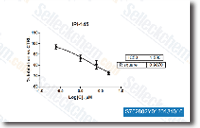C. saccharolyticus creates native cellulases and hemicellulases, enabling it to effectively hydrolyze complicated carbohydrates and make use of the launched mono saccharides as carbon and power sources. On top of that, C. saccharolyticus can grow on biomass which is either pretreated or untreated. Furthermore, C. saccharolyticus is able to co ferment distinct monosaccharides, such as glucose and xylose, without the need of exhibiting carbon ca tabolite repression, and it grows at higher tem peratures and tolerates a broad temperature selection. For the reason that C. saccharolyticus seems very well suited for production of biofuels, its metabolism is extensively studied. Other than hydrogen, acetate certainly is the main fermen tation products, and lactate and ethanol can also be generated by mixed fermentation pathways. C.
saccharolyticus continues to be reported to exhibit improved manufacturing of lactate, a more diminished finish solution, throughout the transition to stationary phase, which over at this website coincides using a drastic reduce in glucose consumption and acetate production. Previous function has proven that the Embden Meyerhof pathway is the principal route for glycolysis in C. saccharolyticus, using a theoretical yield of 4 moles of H2 and 2 moles of acetate per mole of glucose. Examination in the genome sequence reveals the presence of every one of the EM pathway enzymes. No proof is identified to the presence on the Entner Doudoroff and oxidative pentose phosphate pathways in C. saccharolyticus. Identification of metabolites can supply insight into metabolic pathway utilization.
Large resolution, alternative state nuclear magnetic selleckchem resonance spectroscopy can be a beneficial technique for learning the adjustments in concentra tions and fluxes of metabolites that consequence from growth on diverse substrates. NMR allows facile resolution of isomeric constituents and will not des troy the sample. To characterize the monosaccharide metabolism of C. saccharolyticus with the aim of charac terizing its total metabolic prospective for production of bioproducts, the present examine applied 1 D 1H detected NMR spectroscopy together with resonance peak assign ment and curve fitting for metabolite identification and quantification. Deconvolution and curve fitting during the Chenomx software bundle have previously been utilized to determine metabolite profiles within a assortment of microbial metabolomics applications, and these methods were utilized for your purposes of this review.
To confirm the identification and for guide assignment of unidentified metabolites, one D 13C detected and 2 D homo and heteronuclear NMR methods have been utilised to  analyze the metabolic profiles of C. saccharolyticus grown on many monosaccharides. Quite a few novel fermentation merchandise have been recognized and quantified, indicating novel metabolic capacities which can be not predicted while in the current comprehending of metabolism implied from the genome of this thermophilic bacterium and suggesting new potentials for utilization of this organism in manufacturing of bioproducts from cellulosic biomass.
analyze the metabolic profiles of C. saccharolyticus grown on many monosaccharides. Quite a few novel fermentation merchandise have been recognized and quantified, indicating novel metabolic capacities which can be not predicted while in the current comprehending of metabolism implied from the genome of this thermophilic bacterium and suggesting new potentials for utilization of this organism in manufacturing of bioproducts from cellulosic biomass.
No related posts.
